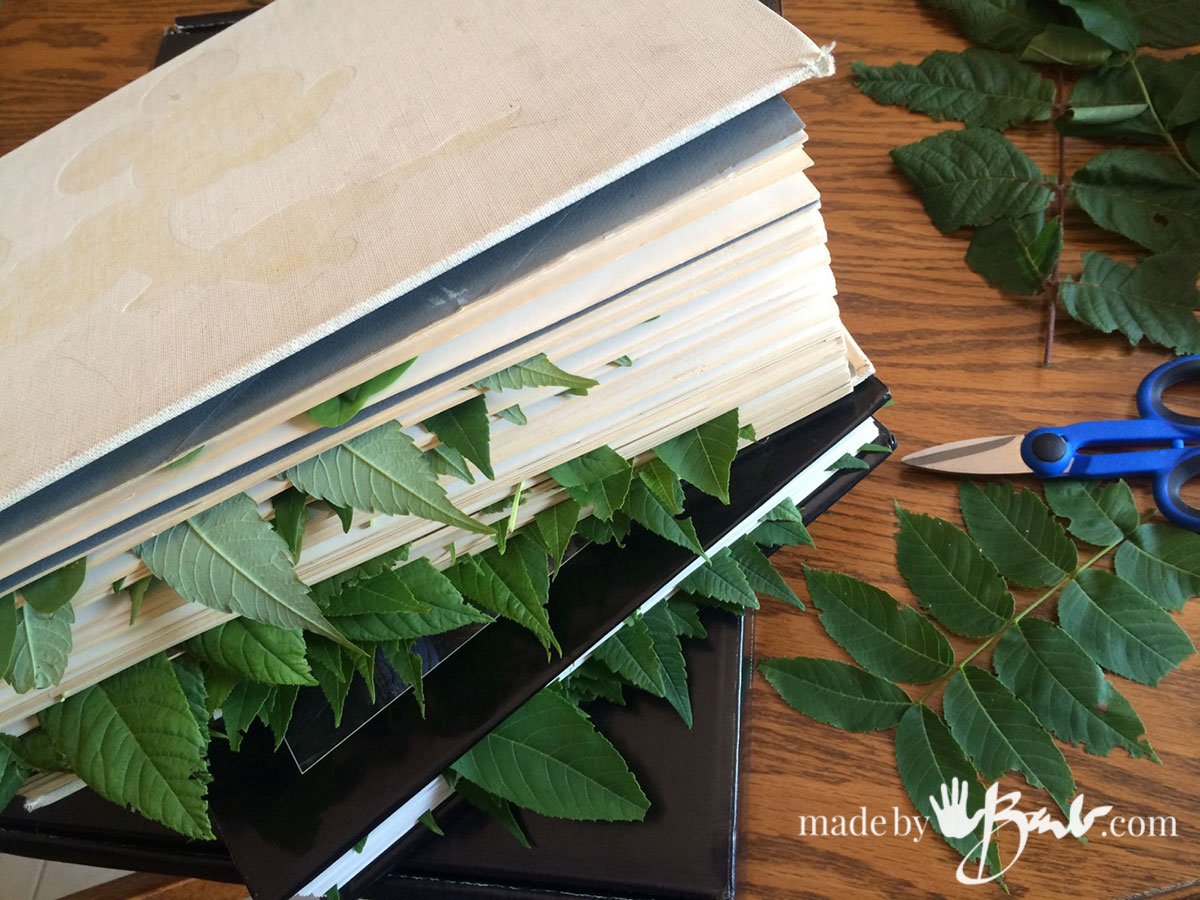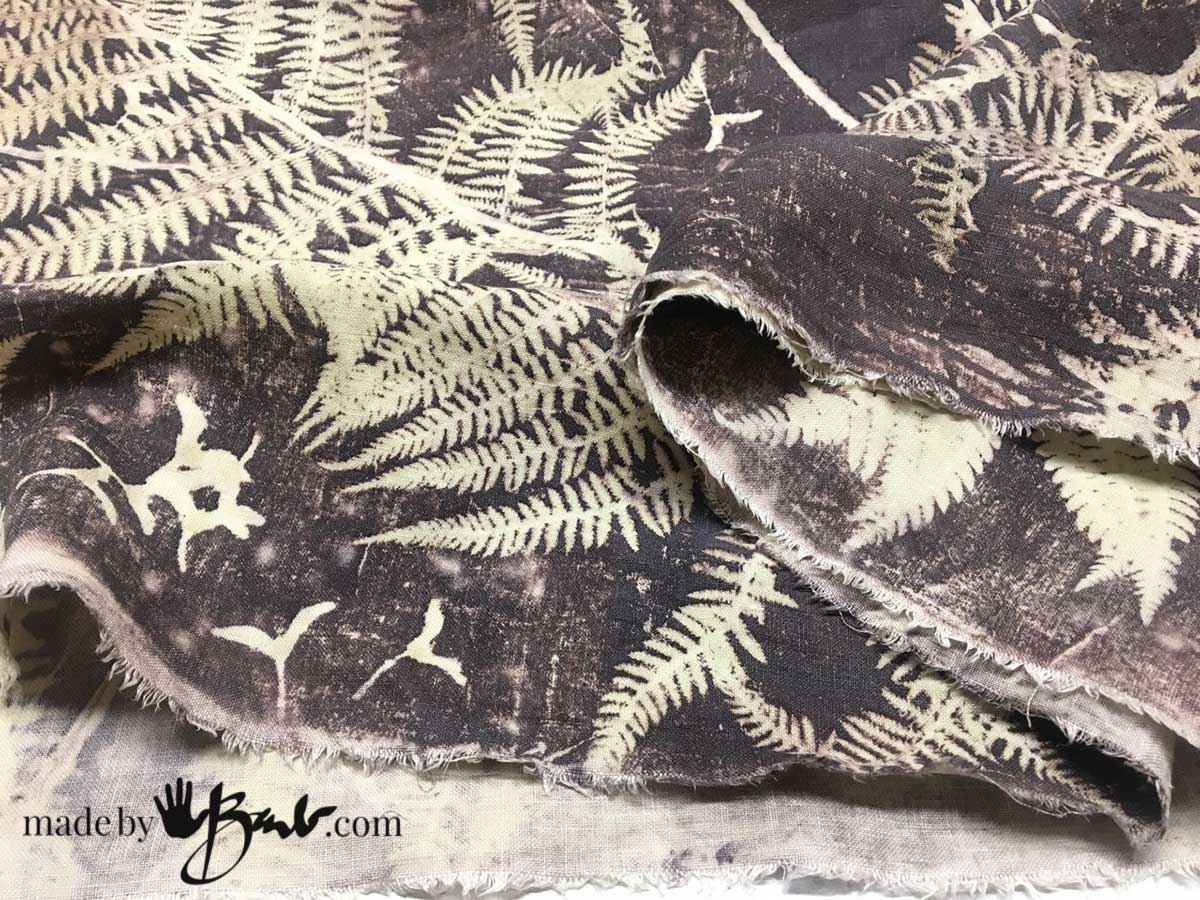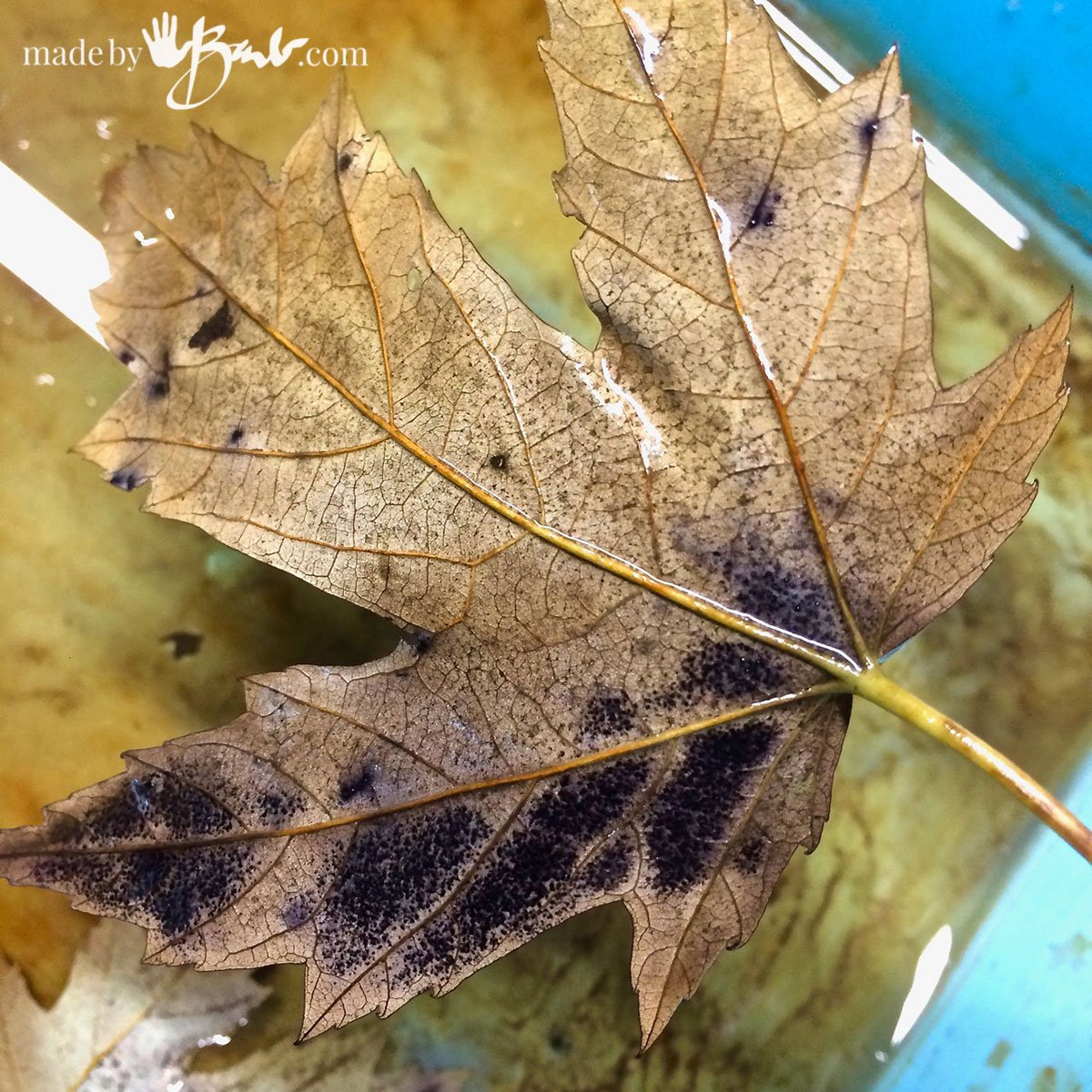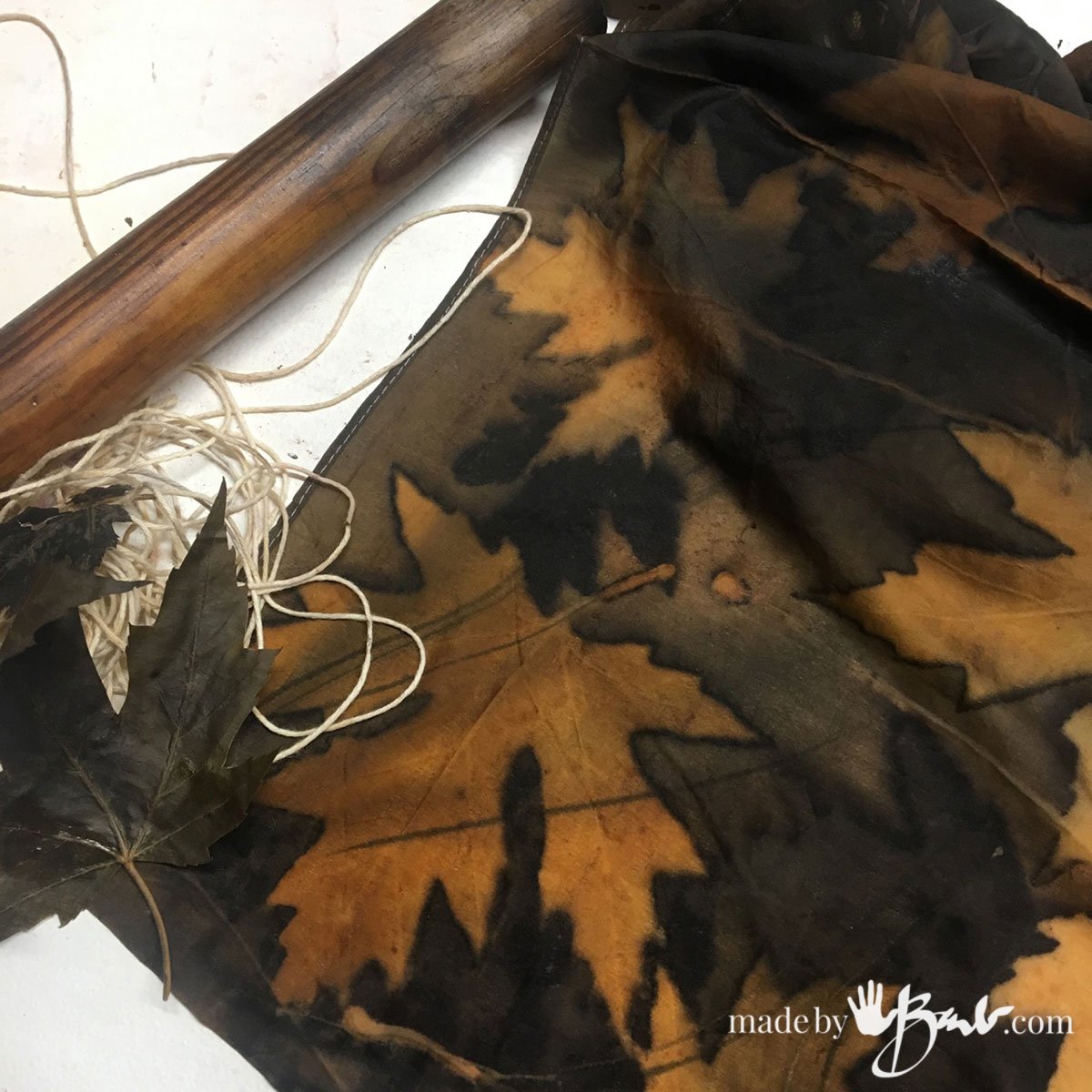My Eco Printing Tips & Tricks
I completely understand! I get so many email questions about Eco printing all the time! I really do know how it is; as I had many of the same questions when I first started. Let me help you out a bit with my Eco Printing tips & Tricks.

I know how you may feel; you see some amazing Eco Print and think it’s really just that simple! ‘Roll up some fabric and leaves and steam (or boil) and you get an amazing print, right? Well maybe, but probably not.

I went through quite a few early attempts and with each would learn something. Some of my first prints looked like I just drove over them with my car; dirty blotches. But I was determined to figure it all out; and I would not even attest that I have, but I now have some (yes some, no one does get all) control on the results.
You have to start somewhere:
Many who have figured it out with their experimentation are not that happy to just give away the secret recipes, hence there are quite a few expensive workshops. Myself; well, that stubborn streak in me sent me on a mission.

Finally some prints:
When I look back at my first true prints I chuckle now; they were exciting at the time but I see how I have progressed in these years of making a bundle on a wood dowel. They were very basic and heavy on the use of iron.
I had started to learn that preparing the fabric is so important! Do make sure the fabric is super clean by scouring well. Also, mordanting according to what fibre you are using makes all the difference. Eco printing on cotton fabric and other cellulose fibres are quite a challenge. Soy milk dips and drying make the cellulose fibre become somewhat ‘protein-like’. As of late I have have been using homemade Aluminum Acetate with quite good results as with the Maple Leaves.

It’s how we roll:
Even with perfectly prepared fabric things can go awry. How it is bundled can also affect the outcome of the prints. This is a contact type of ‘mark making’ so it has to be tight and flat. I dry my leaves to store for later use so they are quite flat (rehydrate before use).
Another issue about bundling is ‘ghosting’ which happens when the prints travel through the layers of the fabric. It’s all about what you prefer but I like clear prints so I use a barrier layer. I use a plastic barrier made from drop sheets and reuse many many times. Paper or other fabric can also be used and then have another purpose afterward.

If you look closely above you will see the lines across the maple leaf. The string wrapping was not dense enough and this translated into the striping across the print.

Making sure the bundles are tied really tight is important. Stay tuned (post coming soon) for my unique innovative method for tight tying without the cut fingers.

‘Why is my print so blurry’? The amount of wetness is also a possible problem in Eco Printing. If there is a lot of water it can flow and leak through causing blurs. I suggest that you wring as best as possible and also don’t submerge the bundle in a water bath to simmer. Some fabrics like thick wool have added challenges as the amount of contact is less due to fibre size and may need extra moisture. That is why tests should be done.
Perfect recipes are not quite easy in this art form as the variables are so great.

Drying & Storing leaves:
I found out the hard way that using books to store leaves is not a good idea. The uneven pressure and tight quarters makes for mold growing when attempting to dry the leaves. Too heavy weight on the stacks will not allow air to pass and dry the leaves. I now have a better system to prepare leaves for storing.

Which Side is best?
When placing the Leaves to Eco Print there is also the question about which side to use. The top side is usually a brighter colour but that does not mean that it will give that colour print. The cells on the bottom vein side of the leaf have thinner walls so they print easier. However this may be one way to achieve the type of print you prefer so it’s not a rule…

All are not Equal:
Don’t be fooled by fancy colours or shapes; not all leaves print well. It is not the colour on the leaf but the tannin that it holds. Every country has it’s best ones and more are discovered by testing all the time.

But there are still ways to use the lesser performers in a resist method. In this linen piece of fabric the ‘resist’ process uses the plant materials to create such amazing shapes.

I love the many maples species available as well as rose leaves, sumac, Weigela, some oak leaves, liquidambars, plum, black walnut, blackberry leaves, not to mention the wonderful eucalyptus leaves available to some.

Take note how colours do not always print as the colours that you see. There are ways to have brighter colours but rarely the exact brilliant colours seen before heat processing.

Protein Fibres print well:
It’s inexpensive to test on old cotton sheets but lovely silk fabrics print & take up dyes so easily. How exciting is it when the bundle gives you the hint of great things to come?! ‘But don’t despair when not every print is great; that makes the great ones more special!

Wool is also a protein fibre and also loves to accept the tannic prints. Wool does not hold moisture well so it brings it’s own challenges but it’s worth it!

Oh, the Iron Question:
Iron is one of the simplest mordants used to achieve prints. It is also a modifier that can even be applied after printing.
When I first started Eco Printing I thought it was great that I could just make my own rusty iron water to aid in the printing. It is true but sometimes I would not know exactly how strong it was or what other metals were in it.

I now use fresh iron water (rust water) solution that I make with Iron Sulphate. Do I have an exact recipe for the strength? ‘Usually no, as I like to vary it and sometimes take an artistic risk to see what might happen. It’s art and I don’t measure my colours when I paint either. But it may be a good idea to keep notes so that you can repeat if magic happens!
Look at this leaf (above)! That dark marking is the reaction of the natural tannins and the iron solution; the basics of eco printing. This leaf was left in the iron water for a long time.

Why Are my prints so dark?
Yes, I love what iron brings to the art form most of the time! It’s been an important player in the history of dyeing and pigments but it can also be frustrating. Here the prints are quite dark and dulled due to an overuse of iron. Thinner and lighter fabrics need less as concentration is calculated to the WOF (weight of dry fibre).

Where does this colour come from?
When you see some amazing colour in Eco Printing it is often from combining with a natural dye. Madder Root, Cochineal and Logwood all bring amazing colours and effects to the table. Other ‘helpers’ such as tannins can come in the forms of teas, such as Myrobalan and Pomegranate.

Look at all the amazing combinations of colours! Even indigo can be brought into the mix before or after and eco printing round.

Some great Byproducts:
I’ll admit that my favourite method is usually with the use of the iron blanket, and it gives some great prints on the iron blankets as well. These can used for various purposes!

It’s a lot of Science:
I won’t even pretend that I am a science-pro but I am a good observer! Eco printing is a testament to reactions of PH levels. Many colours from natural dyes are so sensitive to acids that amazing magical things happen! What was all one bright pink is now many colours of the rainbow! How wonderful can nature be?!

Can we really anticipate exactly what result we will get?! I think not! If we could then it would not be as interesting or give us the drive to take on the challenge.

Go Ahead and get your fingers dirty!
Yup, fingers of all colours! These are ‘cochineal’ pink since we are a ‘protein fibre’! Other times mine are dark from iron staining. But don’t worry a soak in some lemon juice (or citric acid) will brighten and clean them up!
You’ll collect a few buckets (for soaking, mordanting, washing and dyeing) and be seen bent over picking up leaves quite often!
Great all that printing. But how do you get the color on cotton and how it stays on it. With the colored cotton cloths, which are first dyed in a separate bath?
They are such beautiful colors.
With cotton, the color does not want to stay with me.
I hope you will make a book about this. With warm regards.
Sincerely
Cotton is not he easiest to print. You need to mordant the fabric properly first. See here as well. Yes, they are dyed first, maybe start with just using an iron blanket Keep experimenting…
I like to have a book off your beautiful eco prints and explanation.
Please let me know iff there is a book.
Je viens de lire votre article avec beaucoup d’intérêt. J’ai fait des expériences d’écoprinting mais je suis toujours en quête d’amélioration. Ainsi je viens de comprendre que mes ombres sont certainement trop fortes parce que j’utilise trop de fer. Il faudra que j’aie la main plus légère une autre fois. Pour les couleurs de fond, je vois qu’il est possible d’employer, par exemple, de la cochenille pour rosir le fond des impressions. Mais est-ce dans le même bain, saupoudre-t-on le tissu avant la cuisson “vapeur” ? J’aurais besoin de plus d’explications, probablement. En tout cas, je garde ce blog parmi mes favoris et je vais entreprendre sa lecture. Parfois j’arrive à remonter jusqu’au jour 1 du blog …. Merci pour ces explications très utiles et même indispensables !!!
Wow. What an amazing technique. The end results are beautiful!! Your creations are absolutely gorgeous.
Thank you! It is a magical way of using nature!
I wanna know that how many washes it can bear. and how long last the prints of natural products are. Can you please guide me . if any mordant is used to make it long last or what??
That’s a lot of questions. If properly mordanted and use of non-fugitive dyes and high tannin leaves then it will last long. Sunlight is always very harsh so that is not recommended. In early days dyes were mostly of the natural type and some have stood the test of time. Detergents used also matters. I can not give a wide general statement but yes, my scarves have lasted well and there many ways to mordant and prepare the fabrics. Choice of fabric also does matter.
Thank you so much for all the info, and what a beautiful prints you have made. How did you get that beautiful dark red colour?
Just starting with all this, and loving it, and all the experimenting. Great inspiration!
Haha, there are links in the post to the different use of the natural dyes. I think the one you may see is madder root Experimenting is the key as all the varying factors can influence results. Get ready to be addicted…
Hi Barb. I love your blogs. Learned a lot. Have started printing about 2 months ago and have been quit successful on cotton and silk. I live in South Africa and it seems our indiginous trees print very well.
That’s great to hear! It’s all about trying and trying some more…
I am learning a lot with your post. So many important details. Thank you!!
It’s much fun and somewhat unpredictable so it’s even more fun…
Hi Thanks a lot your blog is Awesome
I Just started this Week in this eco print techniche. I have a quesitos : how long I have had at the microwave?
Thanks , I really apreciate your help!!
Check this post as it is not in the microwave that long, but insulated for quite a while. Too much at once will burst the plastic and possibly melt things… Be aware of temperature, just like cooking/baking.
Hi Barb –
My sister and I just tested your microwave method for eco dyeing with cochineal. It turned out great! We each cut out our fabrics for making a top and dress before we eco dyed – hers linen, mine rayon – and microwaved all of the bundles for 2 minutes and then left them under a pile of blankets for 24 hours. They were still hot when we opened them! It was interesting to see how the different fabrics took the dye – the rayon leaves were more subtle, with the cochineal background turning soft purpley-gray. The linen kept the vibrant fuschia color and the leaves had more contrast.
I love your microwave method! No wasted energy, no mess, quick work! You can check my Instagram for photos https://www.instagram.com/auntdebbiehalloween/?hl=en
Thank you so much for sharing your research!
Debbie
Estou encantada com sua experiência amor a arte da impressão Botânica…Me encantou tb estou segurando tb não tenho espaço faço o possível.mas quero testar micro ondas me ajudaria muito…pois só tenho meu quarto moro com minha filha eles n acham interessante meu desejo de me aperfeiçoar na área…Tenho feito umas Ecobegs…Vou continuar persistindo pois isso me tirou da depressão…Obrigada adoro suas dicas preciosas! Zairê
Eco printing is an interesting art form and has so many variables that will give different results. My first prints just looked like dirty cloth. I have many posts, making tests will give the best information.